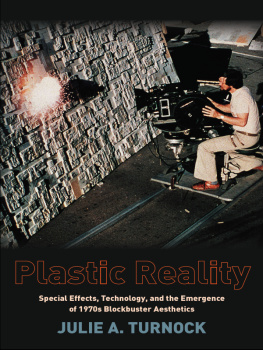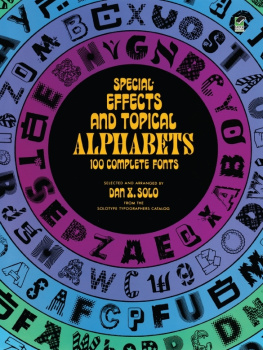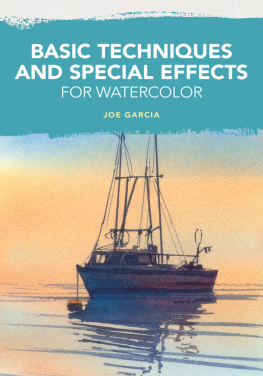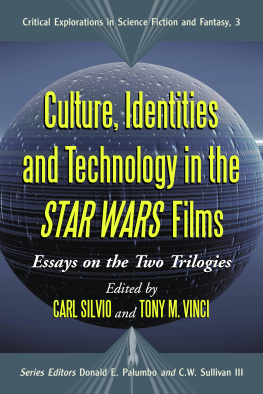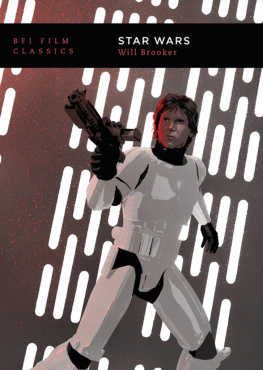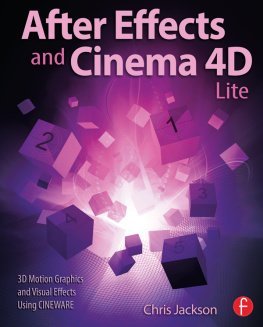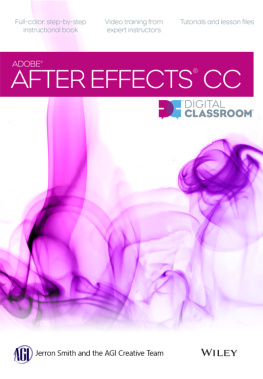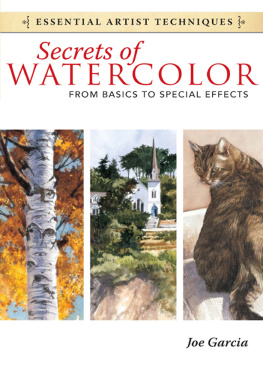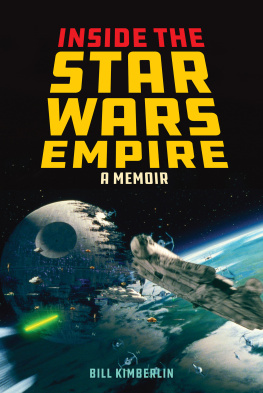Plastic Reality
FILM AND CULTURE
John Belton, Editor
FILM AND CULTURE
A series of Columbia University Press
Edited by John Belton
For the list of titles in this series, see .
Columbia University Press
Publishers Since 1893
New York Chichester, West Sussex
cup.columbia.edu
Copyright 2015 Columbia University Press
COVER PHOTO: The Kobal Collection at Art Resource
COVER DESIGN: Milenda Nan Ok Lee
All rights reserved
E-ISBN 978-0-231-53527-4
Library of Congress Cataloging-in-Publication Data
Turnock, Julie A.
Plastic reality : special effects, technology, and the emergence of 1970s blockbuster aesthetics / Julie A. Turnock.
pages cm. (Film and culture)
Includes bibliographical references and index.
ISBN 978-0-231-16352-1 (cloth : alk. paper) ISBN 978-0-231-16353-8 (pbk. : alk. paper)
ISBN 978-0-231-53527-4 (ebook)
1. Blockbusters (Motion pictures). 2. CinematographySpecial effects. I. Title.
PN1995.9.B598T87 2014
791.43'75dc23
2014026529
A Columbia University Press E-book.
CUP would be pleased to hear about your reading experience with this e-book at .
References to Internet Web sites (URLs) were accurate at the time of writing. Neither the author nor Columbia University Press is responsible for URLs that may have expired or changed since the manuscript was prepared.
To my parents,
Ann and Jack Turnock
Contents
Over the last decade, this book has benefited immeasurably from the input and advice from many others. At the University of Chicago, I must first of all thank Tom Gunning and Jim Lastra, who encouraged, critiqued, and pushed me through the multiple stages of this project. This project is also dedicated to the memory of Miriam Hansen, who read and commented on selections, and for her extremely insightful suggestions. Tom, Jim, and Miriam not only helped the book take form but also provided inspirational models in their own work. Many classmates and colleagues have proved to be invaluable in reading chapters and offering comments as this work progressed: Doron Galili, Andrew Johnston, Sarah Keller, Dan Morgan, Christina Peterson, and Theresa Scandiffio. I particularly want to thank Andrew and Christina for their technical assistance.
Many other friends and colleagues have provided comments, research tips, and encouragement, and I especially want to thank Emily Carman, Ken Eisenstein, Allyson Field, Adam Hart, Matt Hauske, Laura Horak, Nathan Holmes, Katharina Loew, Scott Richmond, Ariel Rogers, Allison Whitney, and Josh Yumibe. Additionally, I want to thank the participants in the Mass Culture workshop, and the 20072008 Affiliated Fellows group at the University of Chicago, notably Neil Verma and Neil Chudgar, for reading and discussing my project.
Many other academics have also been generous with their time and suggestions, and I would like to express my gratitude to John Belton, Scott Bukatman, Don Crafton, Thomas Elsaesser, Scott Higgins, David James, Alison McMahan, James Naremore, Murray Pomerance, Eleftheria Thanouli, Kristen Whissel, Jennifer Wild, and Mark Williams. I am especially grateful to J. B. Capino, Sarah Projansky, Angharad Valdivia, C. L. Cole, and the Unit for Criticism at the University of Illinois, Urbana, for their support of this project. Also at Illinois, former and current graduate students, Alicia Kozma proved an invaluable research assistant, and thanks to Audrey Evrard for checking my French translations. Richard Rickitt has graciously allowed me to reproduce several very useful diagrams from his book. I have also been fortunate to work with Jennifer Crewe, Kathryn Schell, and Roy Thomas at Columbia University Press, who have patiently helped me through the manuscripts various stages, and Cynthia Savage, who did the index.
This book could not have been finished without the generous support of a number of sources. Most importantly, a Whiting Foundation Fellowship granted me time to write and to conduct research travel to Los Angeles. Additionally, I received short-term travel grants from the University of Chicago Humanities Division, Cinema and Media Studies travel funds, and the Nicholson Center for British Studies. Over the revising period, I am grateful for a Mellon/ACLS Early Career Fellowship carried out at the University of California, Davis, Institute for the Humanities, and thank Jennifer Langdon and Carolyn de la Pea for hosting me there.
For help with matters both research-related and logistical in Los Angeles, many people and research institutions provided support, including Mark Toscano, May Haduong, and Brian Meacham at the Academy of Motion Picture Arts and Sciences Pickford Center, Ned Comstock at the USC Cinema Library, Coco Halverston at CalArts, and Mark Quigley at the UCLA Film and Television archive. Also, Barbara Hall and Jenny Romero at the Academys Margaret Herrick Library, and Stephanie Sapienza at the Iota Center. In the U.K., those at the Stanley Kubrick Archive at the University of the Arts and Special Collections in London were especially kind and helpful: Sara Mahurter, Jessica Womack, Richard Daniels, and Wendy Russell.
I was fortunate to be able to meet a good number of people involved with special effects in the 1970s and 1980s, and I am especially grateful to Gerry Harding, Sarah Kareem, David Larson, Steve Merel, Patty Rhodes, John Swallow, and Mark Toscano for putting me in touch with many of my interview subjects. Finally, on the research front, I want to express my enormous debt to those who served as interview subjects in Los Angeles and London: Betzy Bromberg, Joy Cuff, John Dykstra, Syd Dutton, Bill Gilman, Brian Johnson, Tim Johnson, Peter Kuran, Sandra Lee, Bryan Loftus, Pat ONeill (particularly for suggesting the title), John Swallow, Bill Taylor, Richard Winn Taylor, and John Whitney Jr.
On a more personal note, thanks to my sisters Jennifer Harding and Amy McMahon, who always supported me and made me laugh when I needed to throughout this long process, and to their families (Pat McMahon, Chris Harding, John, Zoe, Nora, and Nick). A word of thanks to Jonathan Knipp, because there is no one I would rather see Transformers 3 with, and all the Transformers yet to come. Most of all, I want to express my love and appreciation to my parents, Ann and Jack Turnock who have patiently and steadfastly encouraged me through my academic career.
I hope I never hear the term special effects again.
STEVEN SPIELBERG (1977)
I have never been a science fiction buff.
DOUGLAS TRUMBULL, SPECIAL EFFECTS SUPERVISOR ON CLOSE ENCOUNTERS OF THE THIRD KIND AND BLADE RUNNER, AS WELL AS DIRECTOR OF SILENT RUNNING AND BRAINSTORM
I was never into effects work [in other films].
BETZY BROMBERG, EXPERIMENTAL FILMMAKER AND SPECIAL EFFECTS ARTIST ON WOLFEN AND THE TERMINATOR
The quotations above represent a sampling of statements by many of the most prominent participants in the special effects boom of the late 1970s and early 1980s. Why such a resistance to science fiction and special effects, even by those most closely associated with it? One might expect the notion of highly manipulated imagery masquerading as seamless realism was anathema to many 1960s and 1970s filmmakers steeped in filmmaking polemics favoring a stripped-down authenticity. Certainly many proponents of the so-called New Hollywood of the 1960s and 1970s share these misgivings, for whom films such as

